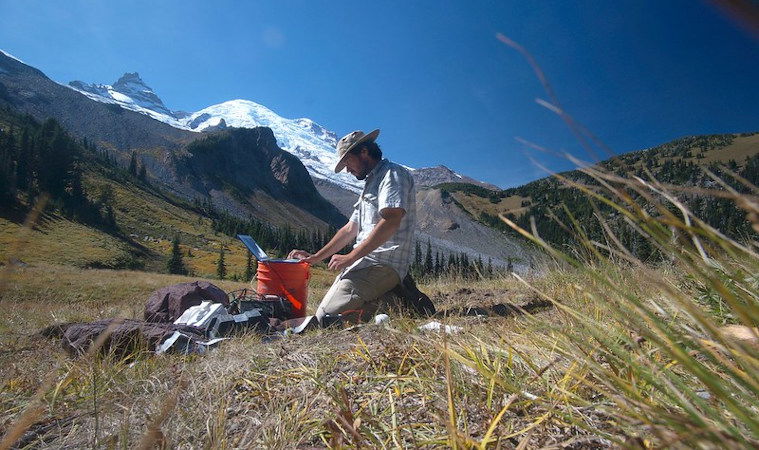After nearly 20 years, OSU researchers complete electrical mapping project critical to protecting US power grid

CORVALLIS, Ore. (KTVZ) – A nearly 20-year effort to map the electrical properties of Earth’s crust and mantle across the contiguous United States, viewed as critical to protecting the electrical grid during extreme solar storms and against damage from electromagnetic pulses used as weapons, is now complete.
The 3-D geoelectric map produced by researchers provides vital information to scientists, power companies and others that helps them understand how the naturally occurring geomagnetic currents under the surface interface with the power grid.
The new map also could be used to identify geohazards and potential targets for exploration of natural resources, including geothermal power and critical minerals that are essential to clean energy technology development.
“Before, we had a patchwork quilt of information, but we could not connect the dots,” said Adam Schultz, a professor in Oregon State University’s College of Earth, Ocean, and Atmospheric Sciences and the project’s principal investigator, “Now we can see the entire picture.”
Extreme solar storms are “space weather” events that naturally occur when disturbances in the solar atmosphere cause streams of charged particles toward Earth; the particles can strongly disturb Earth’s magnetic field.
Electromagnetic pulses are sudden bursts of electromagnetic radiation, such as those following an intentional nuclear detonation, that can cause widespread electric disruption, even if the detonation occurs in space. Such pulses share some important characteristics with naturally occurring solar storm events, Schultz said.
In May, Earth experienced its strongest solar storm in more than 30 years, causing bright and long-lasting views of the aurora borealis, or northern lights, across large swaths of the United States and elsewhere. But the storm also affected radio and some cellular phone service and caused power grid irregularities and problems with GPS systems.
“We didn’t see any wide-scale power issues during that storm and the power industry had access to the data we have provided through this effort, so that’s an indication of the project’s success,” Schultz said. “This is vital information that helps tell them how geomagnetic currents will interface with electrical substations.”
Oregon State University researchers’ effort to measure and map the electrical conductivity of Earth first began about 18 years ago with funding from the National Science Foundation’s EarthScope Program.
The initial intent of the Magnetotelleric Array project, managed then by the Incorporated Research Institutions for Seismology and carried out by Schultz’s research group at Oregon State, was to collect information about the structure and evolution of the North American continent.
Starting in 2006 in Eastern Oregon, researchers deployed instruments across a grid every 70 kilometers or so to survey the electromagnetic energy below the surface. The first-ever 3D view of the continent’s geoelectrical structure created through this process is fundamental to understanding the evolution of the continent, Schultz said.
“We discovered previously unknown structures in the fabric of the continent that reveal how the territory of the conterminous U.S. was formed,” he said.
As data rolled in, the researchers realized the information being amassed also could be valuable in identifying geological hazards, areas for geothermal power exploration, sites for exploration of critical minerals and for protecting the power grid from space weather.
“Geomagnetically induced electrical currents are always running through the power grid, and understanding how the grid is going to be stressed by these currents is critical to keeping the power grid functioning,” Schultz said. “This is a risk we can do something about, and we’re actually doing it.”
When the EarthScope program ended, NASA, with its interest in space weather, funded the project for two years. With support from the Oregon congressional delegation including senators Jeff Merkley and Ron Wyden and following a visit to the White House to meet with national security officials, Schultz secured funding from the U.S. Geological Survey in 2020 to complete the final phase of the work, which was completed in June.
Oregon State’s National Geoelectromagnetic Facility is the largest facility for this type of measurement in the world, making the university a natural fit for the project, Schultz said. In all, Schultz and his team received nearly $15 million in federal grants to support the work.
Researchers have been sharing data collecting during the project on the EarthScope website. Now the first 300 kilometers of the entire U.S., from surface through the Earth’s mantle and crust, are visible in 3D, Schultz said.
With the entire map now in view, patterns of conductivity below the surface have revealed new information about the geology of the U.S. The data showed, for example, a sharp transition in the structure of the Earth’s crust that runs along the East Coast from Washington, D.C. to Georgia, putting that area at higher risk in a big geomagnetic storm like the one that occurred in May.
“That crustal transition can greatly amplify geomagnetically induced currents that the power grid in that region is not designed to handle,” Schultz said.
Additional research is needed in these kinds of high-hazard areas so that researchers can obtain higher resolution records of the structure and better understand the implications, he said. Similar mapping projects inspired by Schultz and his team’s work are also now underway or being considered in several other countries, he noted.